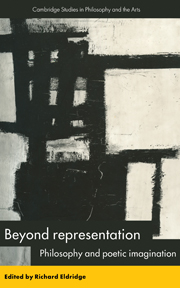Book contents
- Frontmatter
- Contents
- List of contributors
- Editor's acknowledgments
- 1 Introduction: from representation to poiesis
- 2 Confession and forgiveness: Hegel's poetics of action
- 3 The values of articulation: aesthetics after the aesthetic ideology
- 4 In their own voice: philosophical writing and actual experience
- 5 Poetry and truth-conditions
- 6 Fractal contours: chaos and system in the Romantic fragment
- 7 The mind's horizon
- 8 Kant, Hölderlin, and the experience of longing
- 9 Wordsworth and the reception of poetry
- 10 Self-consciousness, social guilt, and Romantic poetry: Coleridge's Ancient Mariner and Wordsworth's Old Pedlar
- 11 Her blood and his mirror: Mary Coleridge, Luce Irigaray, and the female self
- 12 Scene: an exchange of letters
- Index
11 - Her blood and his mirror: Mary Coleridge, Luce Irigaray, and the female self
Published online by Cambridge University Press: 06 July 2010
- Frontmatter
- Contents
- List of contributors
- Editor's acknowledgments
- 1 Introduction: from representation to poiesis
- 2 Confession and forgiveness: Hegel's poetics of action
- 3 The values of articulation: aesthetics after the aesthetic ideology
- 4 In their own voice: philosophical writing and actual experience
- 5 Poetry and truth-conditions
- 6 Fractal contours: chaos and system in the Romantic fragment
- 7 The mind's horizon
- 8 Kant, Hölderlin, and the experience of longing
- 9 Wordsworth and the reception of poetry
- 10 Self-consciousness, social guilt, and Romantic poetry: Coleridge's Ancient Mariner and Wordsworth's Old Pedlar
- 11 Her blood and his mirror: Mary Coleridge, Luce Irigaray, and the female self
- 12 Scene: an exchange of letters
- Index
Summary
What is it to write as a woman? It is not just opponents of feminism who have argued against trying to find specific features in texts by female authors that represent either “the existence of a specifically feminine psychology,” or a “feminine” form of discourse that must always and necessarily undermine the authority of a “masculine” symbolic language. Thus, for example, Rita Felski has urged fellow feminists to move beyond “any theoretical position which argues a necessary or privileged relationship between female gender and a particular kind of literary structure, style, or form.” Writing by women is, she claims, “a social and historical problem rather than a purely theoretical one.” What is required is not feminist aesthetics, but “a sociologically based analysis of the reception of artworks in relation to specific audiences.”
There are many virtues in Felski's critique of those who treat the “feminine” in ahistorical and context-blind ways. It is, however, not necessary to conclude that sociological analysis is the only legitimate means of focusing on the relationships between being female and particular forms of artistic expression. What I wish to do in this essay is to work towards a non-essentialist and more historically specific account of female writing: one that does not, I believe, fall victim to Felski's critique of “feminine” psychology. Indeed, as this argument will illustrate, “feminine” is very much the wrong word to describe what is specific to the female authorial predicament from the Romantics on.
My argument will suggest (against Felski) that in modern Western culture there are characteristic features of the female subject-position which are likely to reveal themselves in texts.
- Type
- Chapter
- Information
- Beyond RepresentationPhilosophy and Poetic Imagination, pp. 249 - 272Publisher: Cambridge University PressPrint publication year: 1996
- 1
- Cited by



